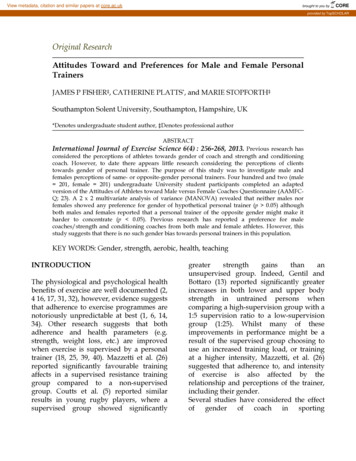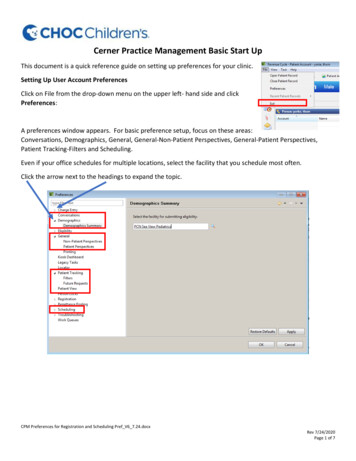
Transcription
View metadata, citation and similar papers at core.ac.ukbrought to you byCOREprovided by TopSCHOLAROriginal ResearchAttitudes Toward and Preferences for Male and Female PersonalTrainersJAMES P FISHER‡, CATHERINE PLATTS*, and MARIE STOPFORTH‡Southampton Solent University, Southampton, Hampshire, UK*Denotes undergraduate student author, ‡Denotes professional authorABSTRACTInternational Journal of Exercise Science 6(4) : 256-268, 2013. Previous research hasconsidered the perceptions of athletes towards gender of coach and strength and conditioningcoach. However, to date there appears little research considering the perceptions of clientstowards gender of personal trainer. The purpose of this study was to investigate male andfemales perceptions of same- or opposite-gender personal trainers. Four hundred and two (male 201, female 201) undergraduate University student participants completed an adaptedversion of the Attitudes of Athletes toward Male versus Female Coaches Questionnaire (AAMFCQ; 23). A 2 x 2 multivariate analysis of variance (MANOVA) revealed that neither males norfemales showed any preference for gender of hypothetical personal trainer (p 0.05) althoughboth males and females reported that a personal trainer of the opposite gender might make itharder to concentrate (p 0.05). Previous research has reported a preference for malecoaches/strength and conditioning coaches from both male and female athletes. However, thisstudy suggests that there is no such gender bias towards personal trainers in this population.KEY WORDS: Gender, strength, aerobic, health, teachingINTRODUCTIONThe physiological and psychological healthbenefits of exercise are well documented (2,4 16, 17, 31, 32), however, evidence suggeststhat adherence to exercise programmes arenotoriously unpredictable at best (1, 6, 14,34). Other research suggests that bothadherence and health parameters (e.g.strength, weight loss, etc.) are improvedwhen exercise is supervised by a personaltrainer (18, 25, 39, 40). Mazzetti et al. (26)reported significantly favourable trainingaffects in a supervised resistance traininggroup compared to a non-supervisedgroup. Coutts et al. (5) reported similarresults in young rugby players, where asupervised group showed d group. Indeed, Gentil andBottaro (13) reported significantly greaterincreases in both lower and upper bodystrength in untrained persons whencomparing a high-supervision group with a1:5 supervision ratio to a low-supervisiongroup (1:25). Whilst many of theseimprovements in performance might be aresult of the supervised group choosing touse an increased training load, or trainingat a higher intensity, Mazzetti, et al. (26)suggested that adherence to, and intensityof exercise is also affected by therelationship and perceptions of the trainer,including their gender.Several studies have considered the effectofgenderofcoachinsporting
ATTITUDES TOWARD MALE AND FEMALE PERSONAL TRAINERSenvironments such as, athletics (10),volleyball and basketball (15) and strengthand conditioning (23). Parkhouse andWilliams (36) and Weinberg et al. (41)reported that male athletes’ attitudestowards female coaches were of a negativeorientation. In addition female athletespreferred the possibility of having anunsuccessful male coach to that of asuccessful female coach (43). Qualitativeresearch has reported that 8 out of 12collegiate female athletes (basketball,softball, golf, cross-country, track and fieldand soccer) also preferred a male coach(11). However, Medwechuk and Crossman(28) reported that swimmers had apreference for same-gender coaches. Morerecently, research has suggested that malecollegiate athletes prefer male strength andconditioning coaches, whereas femalecollegiate athletes do not have a genderpreference for strength and conditioningcoaches (23).communication. As a result of these factors,and in conclusion, the authors stated that 4out of 5 participants showed a preferencefor a female personal trainer (29). Inaddition personal trainers also seem tobelieve that their gender is influential ontheir selection by potential clients (30).Many of these themes are reflected byresearch with athletic coaches; that therewere stronger relationships between femaleathletes and female coaches, and that theymight be friends and could discuss thingsoutside of sport (11). Participants in each ofthese studies commented that the presenceof their female personal trainer/coachhelpedmotivateandencourageperformance (11, 22, 29).Interestingly, until now, there has beenvery little research concerning clients’attitudes toward personal trainers (29), andno research directly considering the effectof gender of personal trainer, or potentialclients’ perceptions regarding adherence,performance, communication, etc. It seemsthat a growing and competitive health andfitnessindustrymightbenefitbymaximizing the desirability of membershipand attendance to their facilities and staff.Based on the physical and psychologicalhealth benefits associated with exercise (2,4, 16, 17, 31, 32), along with the potentiallysuperior results when this exercise issupervised (5, 13, 26), the present studyaimed to examine the perceptions of maleand female clients towards male and femalepersonal trainers.The limited research considering the viewsand experiences of females towardspersonal trainers are qualitative in natureusing small sample sizes (22, 29). Madesonet al. (22) reported that clients state therelationship with their personal trainer isvery important, mentioning the detail andlevel of intimacy of their conversations. Inaddition they discussed trainer skills andcharacteristics, specifically mentioninggender. Female clients believed they wouldnot have the same ‘connection’ with a malepersonal trainer since a male personaltrainer would not have the sameunderstanding of female’s bodies. Melton etal. (29, 30) supported that gender plays amajor role in the selection of a personaltrainer, as well as reporting commentsaround a ‘socially friendly environment’including skills such as empathy, andInternational Journal of Exercise ScienceMETHODSParticipantsParticipantswere402(male 201,female 201) Undergraduate Universitystudents aged between 18 and 28 years257http://www.intjexersci.com
ATTITUDES TOWARD MALE AND FEMALE PERSONAL TRAINERS(m 21.14, 2.45). A power analysis ofprevious research (23) was conducted todetermine participant numbers (n) using atreatment effect size (ES), calculated usingCohen’s d (3), of 0.46. This was the lowestES calculated from the series of questionsfrom the AAMFC-Q (23) and thusaccommodated a greater range of ES for thepresent study. Participant numbers,calculated using equations from Whitleyand Ball (42), showed that each grouprequired 75 persons to meet the requiredpower of 0.8 at an alpha value of p 0.05.Participants were selected via randomsampling,sinceselectingspecificparticipants who already attended a gymmight bias results due to previousexperiences with a personal trainer.Approval was granted by the relevantUniversity ethics committee board, andeach participant signed an informedconsent document prior to completing thequestionnaire.conditioning coaches, citing a reliability of0.76.In the present study the AAMFC-Q wasadapted by using the term ‘personaltrainer’ instead of ‘coach’. In addition, theopening paragraph of the AAMFC-Q wasalso modified to give the scenario of eithera male, or female, personal trainer and theirqualifications instead of that of a coach:“Sophie (Daniel) has completed her (his)undergraduate degree in Applied SportsScience. She (He) played and competed inher (his) sport at a regional level. Sophie(Daniel) is a certified personal trainer andhas just got a job in your gym. Pleaseanswer the questions below concerningyour feelings about Sophie (Daniel) beingyour new personal trainer.” Whilst theAAMFC-Q (23), as a scale, went from 1; Notat all, to 10; Very much, with an additional11th value, the present scale has beenamended to score from 1-10 only. Theintegrity of the questionnaire remained,with the following amendments to specificquestions (Q): Q2; “His (her) presencewhere we train might make it harder toconcentrate” now reads “His (her) presencemight make me find it harder toconcentrate”. Q3; “He (she) could make mewant to train with greater intensity andefficiency” now reads “He (she) could makeme want to push myself harder withgreater intensity”, Q4 “He (she) might behead coach in 20 years” now reads “I couldtake his (her) criticism if he (she) correctsme during a particular exercise”, Q5; “Icould take it when he (she) corrects mewhen I perform and exercise incorrectly”now reads “I would have the confidencethat he (she) is a good personal trainer”, Q6;“I would have confidence that he (she) is agood strength coach” now reads “I couldtake orders and instructions easily fromProtocolA quantitative research design was used inwhich male and female participantscompleted a modified version of theAthletes Attitudes towards Male andFemale Coaches Questionnaire (AAMFCQ). The AAMFC-Q assesses the feelings offemale and male athletes towards thegender of a coach (41). Test-retest reliabilityhas been reported as 0.80 and 0.77 for maleand female versions respectively (23). Thequestionnaire uses either a female or maleversion, where the narrative preceding thequestions describes either a male or femaletrainer. It consists of 11 single items scoredon a 1-10 Likert scale with response optionsranging from 1; not at all to 10; very much.Magnusen and Rhea (23) further adaptedthe AAMFC-Q, by asking participantsabout attitudes toward strength andInternational Journal of Exercise Science258http://www.intjexersci.com
ATTITUDES TOWARD MALE AND FEMALE PERSONAL TRAINERShim (her)”, Q7; I could take orders andinstructions from him (her) easily” nowreads “I could discuss progress with him(her) easily before/during and aftertraining”, Q8; “I could not take punishmentfrom him (her)” now reads “He (she)would help me with my adherence to theexercise programme”, Q9; “I could discussthingswithhim(her)easilybefore/during/after strength training” nowreads “I would have the confidence in him(her) training me for a strength workout”,Q10; “I might expect him her to motivateand encourage me in my training easily”now reads “I would have confidence in him(her) training me for an aerobic workout”,and Q11; “I might feel angry (mad) if he(she) yelled at me while I was training”now reads “I would prefer it if my personaltrainer were a woman (man). The AAMFCQ (23) also had a 12th question asking “Iwould prefer it if my new strength coachwere a man (woman)”, however theupdated version in the present only utilisedthe 11 questions detailed. The changes wereimplemented since they are more specific toa personal training scenario and to thisspecific area of research (it is important thata client be able to listen to coaching points,e.g. have their form corrected whenexercising, etc.). A complete copy of themodified AAMFC questionnaire now titled‘Attitudes of Clients towards Male versusFemale Personal Trainers Questionnaire(ACMFPT-Q) is shown in Table 1. For thebenefit of the reader the second gender hasbeen added in parentheses, however, on thedistributed questionnaire only one gender(e.g. Daniel or Sophie) was mentioned.were studying fashion design, business,accountancy, law, maritime studies,computing, film & television, politics, orpopular music production. The array ofclasses was selected to best represent abroad spectrum of potential career paths.Each participant randomly selected one oftwo questionnaires (a male or femaleparticipant could receive either a male orfemale personal trainer version of thequestionnaire) with the instruction thatthey were being asked about theirperceptions of a personal trainer. They werenot advised that any comparative studywas being performed or that genderperceptions were being examined.Statistical AnalysisThe questionnaires were first split into twogroups based on the gender of theparticipant. These two groups were thenfurther split based on the gender of thehypothetical personal trainer that wasevaluated by each participant. This yieldedfour groups based on the gender of theparticipant and the gender of thehypotheticalpersonaltrainerbeingevaluated; male participant and malepersonal trainer (MM; n 100), maleparticipant and female personal trainer(MF; n 101), female participant and malepersonal trainer (FM; n 101) and femaleparticipant and female personal trainer (FF;n 100). This method ensured thatparticipants did not compare both genderscenarios which might have allowed a biasto the results.Using the statistics package for the socialsciences (SPSS v.17), a 2 (gender ofparticipant) x 2 (gender of the hypotheticalpersonal trainer) multivariate analysis ofvariance (MANOVA) was used to comparethe independent variables (gender ofUniversity students were asked to selectand complete a questionnaire uponentering one of their normal academicsessions. Students attending these sessionsInternational Journal of Exercise Science259http://www.intjexersci.com
ATTITUDES TOWARD MALE AND FEMALE PERSONAL TRAINERSTable1. Modified Attitudes of Client towards Maleand Female Personal Trainers questionnaire.DIRECTIONS: Please read the following personal training session scenario. After you have finished reading,respond by filling out the questionnaire below.SCENARIO: Sophie (Daniel) has completed her (his) undergraduate degree in Applied Sports Science. She(He) played and competed in her (his) sport at a regional level. Sophie (Daniel) is a certified personal trainerand has just got a job in your gym. Please answer the questions below concerning your feelings aboutSophie (Daniel) being your new personal trainer. Please circle the number 1-10 that corresponds to yourfeelings for each question.1. I would like her (him) as my personal trainer:12345678910Not at allVery Much2. Her (His) presence might make me find it harder to concentrate:12345678910Not at allVery Much3. She (He) could make me want to push myself harder with greater intensity:12345678910Not at allVery Much4. I could take her (his) criticism if she (he) corrects me during a particular exercise:12345678910Not at allVery Much5. I would have the confidence that she (he) is a good personal trainer:12345678910Not at allVery Much6. I could take orders and instructions easily from her (him):12345678910Not at allVery Much7. I could discuss progress with her (him) easily before/during and after training:12345678910Not at allVery Much8. She (He) would help me with my adherence to the exercise programme:12345678910Not at allVery Much9. I would have the confidence in her (him) training me for a strength workout:12345678910Not at allVery Much10. I would have confidence in her (him) training me for an aerobic workout:12345678910Not at allVery Much11. I would prefer it if my personal trainer were a man (woman):12345678910Not at allVery MuchAge Gender (please circle)International Journal of Exercise ScienceFemale260Malehttp://www.intjexersci.com
ATTITUDES TOWARD MALE AND FEMALE PERSONAL TRAINERSparticipant and gender of hypotheticalpersonal trainer) with the 11 items on theACMFPT-Q. An alpha value of p 0.05 wasused to identify statistical significance.Table 2. Mean (SD) Attitudes of Clients towardsMale and Female Personal Trainers Questionnaire(ACMFPT-Q) scores for male and female clients.VariableQ1;likingQ2;Presence &ConcentrationQ3;GreaterintensityQ4;Take criticismQ5;ConfidenceQ6;Orders onfidence –StrengthQ10;Confidence –AerobicQ11;PreferoppositegenderRESULTSAs a result of the MANOVA, significantmean differences were found for gender ofparticipant; (F(11, 388) 8.61, p 0.05), and forgender of hypothetical personal trainer;(F(11, 388) 10.81, p 0.05). Femaleparticipants reported significantly highervalues for both male and female personaltrainerswhencomparedtomaleparticipants (with the exception of question2 which was inversely scored and thussignificantly lower values reported), e.g. thefemale participants scored both genders ofhypothetical trainer higher than maleswhen asked about; liking (Q1), greaterintensity (Q3), taking criticism (Q4),confidence (Q5), orders and instructions(Q6), discussing progress (Q7), adherence(Q8), confidence - strength (Q9), confidence- aerobic (Q10). See table 2 for mean values(SD) and effect sizes (ES) calculatedCohen’s d (3).EffectSize5.80 (2.22)*FemaleClientsMean (SD)6.88 (1.63)*3.96 (2.43)*3.03 (2.00)*0.426.01 (2.07)*7.03 (1.74)*0.546.60 (2.36)*7.61 (1.58)*0.516.52 (2.10)*7.30 (1.52)*0.436.48 (2.23)*7.43 (1.65)*0.497.05 (1.92)*7.43 (1.76)*0.216.21 (2.15)*7.23 (1.59)*0.556.05 (2.33)*7.35 (1.59)*0.666.72 (2.06)*7.30 (1.68)*0.314.46 (2.75)3.55 (2.48)0.56* Significant differences at 0.05 levelWhen examining the gender of trainersignificant differences identified, (F(11, 388) 10.81, p 0.05) that both male and femaleparticipants scored a hypothetical femalepersonal trainer higher when compared to ahypothetical male trainer in; confidencethat she is a good personal trainer (Q5),ability to take orders and instructions easilyfrom her (Q6), that they could discussthings easily before/during and aftertraining with her (Q7), and that they wouldhave confidence in her training themthrough an aerobic workout (Q10). Seetable 3 for mean values (SD) and effect sizes(ES) calculated Cohen’s d (3).International Journal of Exercise ScienceMale ClientsMean (SD)A significant interaction effect was alsofound between the 2 independent variables;(F(11, 388) 4.53, p 0.0001). Based on thefollow up univariate ANOVAs, the onlysignificant interaction effect occurred atquestion 2 (p 0.05), where both gender ofparticipant reported that the oppositegender of hypothetical personal trainermight make it harder to concentrate (Q2).Using Cohen’s d (3) an effect size of 1.05was calculated.261http://www.intjexersci.com
ATTITUDES TOWARD MALE AND FEMALE PERSONAL TRAINERSadherence to an exercise programme (18),which can in turn, elicit significant healthbenefits (25, 26, 39, 40) this seems apertinent area to consider. Therefore thepresent study sought to examine potentialclients’ attitudes and preferences towardpersonal trainers. Gaining a betterunderstanding of the attitudes towardspersonal trainers could, in turn, lead todefining the factors that contribute tosustained involvement and exercisepreferences.Table 3. Mean (SD) Attitudes of Clients towardsMale and Female Personal Trainers Questionnaire(ACMFPT-Q) scores for male and femalehypothetical personal trainers.VariableQ1;likingQ2;Presence &ConcentrationQ3;GreaterintensityQ4;Take criticismQ5;ConfidenceQ6;Orders onfidence –StrengthQ10;Confidence –AerobicQ11;PreferoppositegenderMale TrainerMean (SD)6.26 (1.88)FemaleTrainerMean (SD)6.41 (2.15)3.62 (2.27)3.67 (2.27)6.63 (1.92)6.41 (2.03)6.95 (2.00)7.23 (2.13)6.69 (1.81)*7.13(1.90)*7.19(2.11)*0.246.77 (1.75)*7.72(1.83)*0.536.60 (1.82)6.84 (2.08)6.82 (1.90)6.59 (2.28)6.51 (1.91)*7.51(1.76)*4.26 (2.69)3.75 (2.61)6.72(1.88)*Effect SizeFemale participants reported significantlymore favourable mean values for both maleand female hypothetical personal trainerswhen compared to male participants (Q110). This response is supported by previousresearch, in which female’s adherence toexercise programmes was improved whenhaving a personal trainer present (18).However, male participants might havescored lower values for either hypotheticalpersonal trainer due to a lack of socialmotives in the gym environment (33, 38).However, the mean score for males (5.80)with regard to liking (Q1) still suggests apositive relationship (e.g. 5.0) towardhypothetical personal trainers. Mullen andWhaley (33) found that women rate socialoutcomes higher than males, with regardsto their commitment within fitness clubmembership. Indeed, previous research hassuggested that persons might findexercising alone less stressful than with afriend (37), and indeed, males specificallypreferred to exercise alone rather than with0.240.54* Significant differences at 0.05 levelDISCUSSIONPrior to the present study no research hadexamined the attitudes and preferencestoward male and female personal trainers.Since having a personal trainer can increaseInternational Journal of Exercise Science262http://www.intjexersci.com
ATTITUDES TOWARD MALE AND FEMALE PERSONAL TRAINERS112Table 4. Mean (SD) Attitudes of Clients towards Male and Female Personal Trainers Questionnaire(ACMFPT-Q) scores for male and female clients with regard to male and female personal trainersVariableQ1;likingQ2;Presence &ConcentrationQ3;GreaterintensityQ4;Take criticismQ5;ConfidenceQ6;Orders onfidence –StrengthQ10;Confidence –AerobicQ11;Prefer oppositegender*SignificantMale ClientsFemale HypotheticalMale HypotheticalPersonal TrainerPersonal TrainerMean (SD)Mean (SD)5.84 (2.26)5.76 (1.94)Female ClientsFemale HypotheticalMale HypotheticalPersonal TrainerPersonal trainerMean (SD)Mean (SD)6.99 (1.59)6.76 (1.67)4.43 (2.34) *3.49 (2.44) *2.30 (1.62) *3.76 (2.09) *5.76 (2.13)6.26 (1.99)7.08 (1.69)6.99 (1.80)6.62 (2.43)6.58 (2.30)7.90 (1.53)7.31 (1.59)6.77 (2.24)6.27 (1.91)7.50 (1.40)7.09 (1.60)6.63 (2.42)6.32 (2.02)7.76 (1.58)7.11 (1.65)7.42 (2.00)6.70 (1.78)8.02 (1.60)6.84 (1.72)6.16 (2.40)6.27 (1.87)7.53 (1.41)6.93 (1.70)5.80 (2.60)6.36 (2.00)7.43 (1.50)7.27 (1.67)7.24 (2.05)6.19 (1.93)7.79 (1.34)6.82 (1.84)4.10 (2.80)4.83 (2.65)3.40 (2.35)3.69 (2.61)differencesat0.05International Journal of Exercise Sciencelevel263http://www.intjexersci.com
ATTITUDES TOWARD MALE AND FEMALE PERSONAL TRAINERSa companion (38). Previous researchsupports this suggesting that males spendmore time exercising than females (12, 35).In addition ‘social role theory’ appears to bea significant factor within these results,with males generally showing greater selfconfidence and self-sufficiency (7, 8). Futureresearch into male gym members and theirexercising habits should certainly beconsidered.participants might have had greaterconfidence in a male personal trainer for astrength workout, which our results did notsupport. Whilst the individual goals ofparticipants might have been a factor,future research should investigate whyboth males and females appeared to havegreater confidence in a female personaltrainer (Q5).Both males and female participantsreported a significantly higher score fortaking instructions from (Q6), anddiscussing progress (Q7) with, a femalepersonal trainer. This might also beexplained by social role theory, whichcontends that there are qualities andbehavioural tendencies believed to bedesirable for each gender as well asexpectations regarding the roles men andwomen should occupy (7, 8). Women arestereotyped as more ‘communal’ withattributes such as compassion, tive, nurturing, and generous; andmen as more ‘agentic’ with attributes suchas aggression, forcefulness, self-confidence,and self-sufficiency (7). Research hasreported that females feel strongly about apositive relationship with their personaltrainer/coach, where they could discussmore intimate and private themes outsideof exercise and sports (11, 22, 29). Elitefemalesoccerplayerspositivelycommented on the actual and perceivedcommunicative characteristics of femalecoaches when compared to males;specificallymentioningempathy,understanding and caring attributes infemale coaches (9). Female athletes havereported a more aggressive, authoritativeand intimidating approach by malecoaches, although many female athletesstated a preference for this style believing itInterestingly both males and femalesreported a significantly higher score forhypothetical female personal trainers forconfidence (Q5) and confidence in theirability to train the participant through anaerobic workout (Q10). Previous researchsuggests that both men and women usefitness activities as a means of controllingtheir physical appearance and health butthe choice of exercise is, to some extent,gender-dependent (19, 24). Researcherssuggest that men use weight training tobuild “strong, muscular bodies in the gym”,while women “dominate the aerobics classto sculpt slim, lithe, ‘feminine’ bodies” (19,24). These assumptions of genderdependent choices in exercise could suggestwhy both men and women believe that afemale personal trainer is more competentin training an aerobic workout compared toa male personal trainer. This is supportedby previous research where females havesuggested a preference for a femalepersonal trainer due to understandingstruggles to balance gender-role concerns(e.g. a toned body as well as a femininefigure; 29). Gender appropriate behaviouris largely shaped by socio-cultural imagesof the ideal masculine or feminine body (21,24) and fuelled by media depiction of thesestereotypical masculine or feminine idealbody images (20). However, this might leadto the hypothesis that male and femaleInternational Journal of Exercise Science264http://www.intjexersci.com
ATTITUDES TOWARD MALE AND FEMALE PERSONAL TRAINERSmade them better (11). It might be that eliteathletes are more accommodating orexpecting of a generally authoritativecoaching style (e.g. male), whilst personsless motivated by physical performancemight prefer the idea of an approachablepersonal trainer who is more supportiveand helpful in their exercise prescription(e.g. female).a preference for a specific gender ofhypothetical personal trainer (Q11). Theseresults are different from those of gth and conditioning coaches(10, 15, 23, 41). As mentioned, we suggestthat this contrast might exist due to thedifference in importance of exercise, fitnessand physical conditioning between athletesand the general population. Both male andfemale athletes, who by their nature likelyhold a higher level of importance onphysical conditioning, might suppose thatthey can only continue to improve with,and thus show a preference for, a dominantand aggressive coach/strength coach (11,23), whereas the general public who are notmotivated to the same level of physicalperformance might prefer the idea of ahelpful and approachable personal trainer.Indeed, the nature of these relationships;demanding, assertive and intimidating asopposed to enjoyable, social and friendlyreflect male and female characteristicsrespectively (7, 8).The only significant difference in theinteraction between gender of participantand gender of hypothetical personal traineris that both males and females reported thatthe opposite gender personal trainer mightmake it harder to concentrate (Q2). Femalesmight have reported a preference to afemale personal trainer due to the socialreasoningbehindfemaleexerciseparticipation (33), and the preferredintimacy of relationship with femalecoaches and personal trainers (9, 11, 22, 29).Indeed males might simply have preferreda more authoritative approach (7, 8) or havehad greater confidence in being trained bysomeone of the same gender (23). However,neither males nor females reported anobjection to the described person as theirpersonal trainer (Q1) or a preference for apersonal trainer of the same gender (Q11),they simply reported that a person of theopposite gender ‘might make it harder toconcentrate’ (Q2). It might be that a subtlequestion about concentration allowed truefeelings to be displayed where a directquestionaboutpreferencecausedparticipants not to want to show anyfavouritism. Certainly, further researchmightinvestigatedistraction,andattraction, as well as other variables withinthe personal training and fitness industry.The results of this study suggest that theparticipants have no bias to the gender of apotential personal trainer. Future researchmight consider as to whether they attachmore important characteristics such asapproachability, attitude, experience andknowledge. Another possibility is that theparticipants in the study could alreadyhave had an effective male or femalepersonal trainer that may positivelyinfluence their attitudes toward gender. Apossible limitation to the study is thatparticipants were not asked as to their gymexperience, or intentions to exercise.However, it was felt that choosing personswho already attended a gym would be aform of selection bias, and questioningparticipants on their opinions wouldA significant finding of the present studywas that neither males nor females reportedInternational Journal of Exercise Science265http://www.intjexersci.com
ATTITUDES TOWARD MALE AND FEMALE PERSONAL TRAINERSprompt recall and experience to bias theiranswers, rather than the described scenario.McClaran (27) describes the stages ofmotivational readiness for exercise as beingwhich could be considered as potentialquestioning in future research. A furtherlimitation might be that the modifiedquestionnaire has not been validated withpersonal trainers and prospective fitnessclients.serves to reinforce the the value of bothmale and female personal trainers.REFERENCES1. Arikawa AY, O’Dougherty M, Schmitz K.Adherence to a strength training intervention inadult women. J Phys Act Health 8: 111-118, , Self-Esteem, and DepressionSymptomatology among Collegiate Athletes versusNon-athletes. J Am Coll Health 57(5): 521- 526, 2009.We might also consider that evolvingexperiences, attitudes and sporting environments might bechanging; perhaps the same studies from1980s (36, 41), and 1990s (10) might notgeneralize to the current day.3. Cohen J. Quantitative Methods in Psychology: APower Primer. Psychol Bull 112(1): 155-159, 1992.4. Colliander EB, Tesch P. Blood pressure inresistance trained athletes. Can J Sport Sci 13: 31-4,1988.5. Coutts AJ, Murphy AJ, Dascombe BJ. Effect ofdirect supervisi
very little research concerning clients' attitudes toward personal trainers (29), and no research directly considering the effect of gender of personal trainer, or potential clients' perceptions regarding adherence, performance, communication, etc. It seems that a growing and competitive health and










